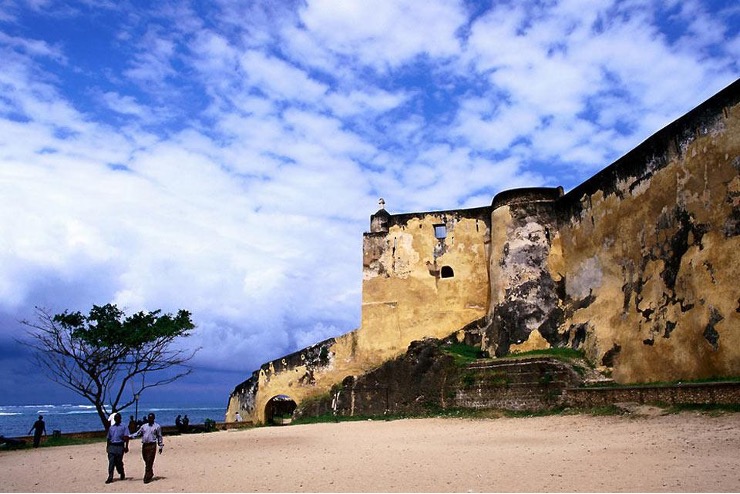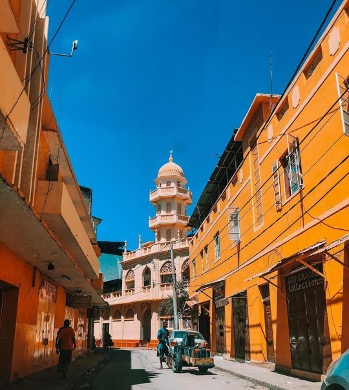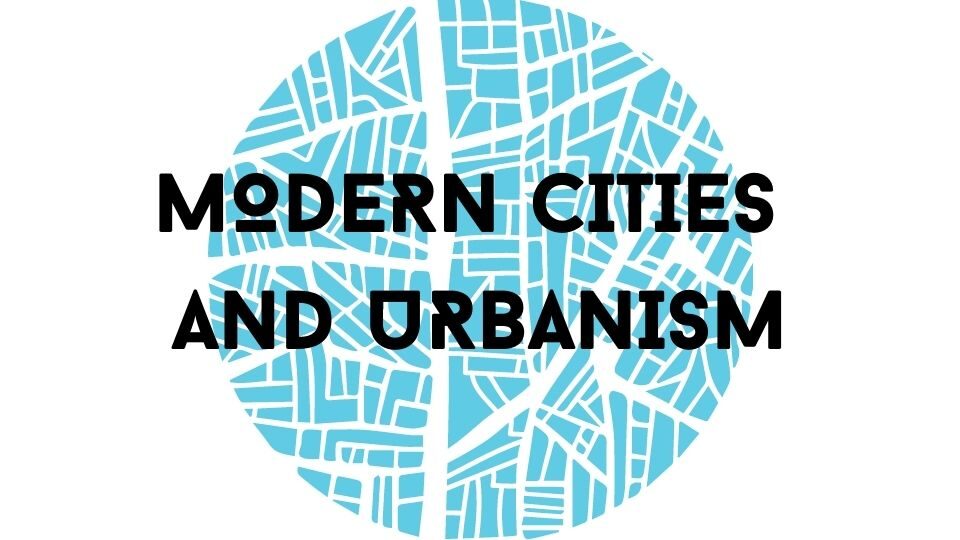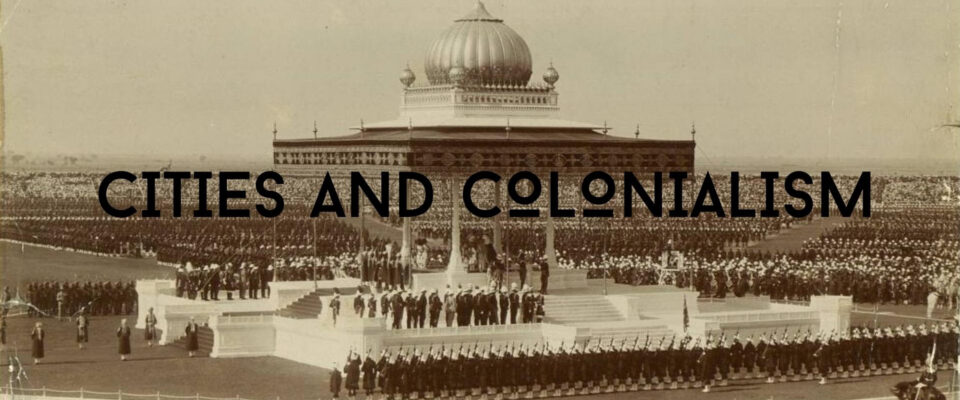The city of Mombasa is located on Kenya’s southeastern coast bordering the Indian Ocean. The city extends from Mombasa Island, a coral outcrop where the Old Town is located, to the Kenyan mainland. Like much of the East African coast, Mombasa was a site of great exchange, tension, and conflict as different foreign and indigenous groups encountered one another. This is certainly true of the city’s experience of colonialism, first by the Portuguese, then the Omanis, and finally by the British, before Kenya gained independence in 1963. The city began to urbanize on Mombasa Island and as such its development is informed by what Gerald Steyn terms its “islandness.” Bounded by the Indian Ocean and two estuaries, the limited space of Mombasa Island informed the development of what can be described as a “layered city.” Different groups who controlled the island built on top of one another and stimulated architectural and design acculturation between disparate groups. The different iterations of colonialism on the island certainly encouraged this acculturation but also resulted in destruction, preservation, and construction as each foreign group took control of the city. This is visible in Mombasa’s architecture and infrastructure, with remnants of these dynamics still present today. A brief survey of Mombasa’s history, with particular attention paid to Mombasa Island, will lay the groundwork for a discussion of various authors’ research into the development of Mombasa as a city and its relationship to colonialism. The first work I will examine is Gerald Steyn’s essay on Mombasa’s islandness and its impact on the development of the city’s urbanism and residential architecture. Then a discussion of Athman H. Athman’s history of Swahili wood carving will demonstrate the influence of the Omani Empire on carpentry in the city. Prita Meier’s research into Mombasa’s “culture of stone” and prevalence of coral as a building material will be cited to highlight the role of the British colonial regime in the construction of racialized hierarchies within the city. Finally, Justus Kithiia and Gamoyo Majambo’s study of Mombasa’s contemporary water and sanitation systems will enable an analysis of how the inequitable dynamics of colonialism still reverberate through Mombasa’s infrastructure today.
Long before Mombasa was established as a hub within the Indian Ocean trading system, and before colonialism would cement its legacy in the stone streets of Mombasa’s Old Town, the area surrounding this burgeoning port town had been settled by Bantu-speaking communities. They engaged in farming, fishing, and local trading with the coastal areas and other archipelagos up and down the coast. The presence of cities in Kenya’s coastal region was first documented as early as 110 AD in the Periplus of the Erythrean Sea. Many other Greco-Roman, Persian, and Arab writers in the centuries after, including Al Idrisi in 1151 and Moroccan traveler Ibn Battuta in 1331, documented the development of Mombasa, including its rise in prominence within the Indian Ocean cloth trade (Otiso, 2005: 75).
From the 10th century onwards, a Swahili culture emerged on the East African coast and laid the foundations for distinctive patterns of development of the city. In the 14th and 15th centuries Islamic urban and trade expansion, influenced by ties to the Arabian Peninsula and India, imprinted its own distinct cultural and architectural practices along the East African coast (Steyn, 2015: 58). Mombasa’s exports across the Indian Ocean included ivory, leopard skins, and enslaved people, which were reciprocated with porcelain, metal artifacts, and cloth coming into the city (Steyn, 2015: 59). Mombasa, and other Arab-dominated city-states along the East African coast such as Lamu and Malindi, were designed with a planned layout with structures made of wattle and mud, with stone rooves (Otiso, 2005: 75).
The arrival of European influence and intervention in the development of Mombasa came in 1498. On route to India, Vasco de Gama landed at Mombasa as part of a wider Portuguese program of African coastal exploration (Steyn, 2015: 59). The Portuguese repeatedly attacked Mombasa during the 1500s until they controlled the city’s trading relationships with foreign powers. By the 16th and 17th centuries, the Portuguese dominated Mombasa and established the basic structure of an urban core, introducing European architecture to what would become Kenya (Otiso, 2005: 76). Remnants of Portuguese colonial architecture—most notably Fort Jesus, which was completed in the 1630s—are still standing. The capture of Fort Jesus by the Mazrui Arabs of Oman in 1698 marked the end of Portuguese rule of the coast and the beginning of Arab rule of Mombasa. During this time the Basheikh and Mandry mosques in the Old Town were constructed (Mutonga, 2015). The city remained under Arab rule shifting from Mazrui control to Seyyid Said, the Sultan of Zanzibar, in 1837 until it was leased to the British East Africa Company in 1887. Soon thereafter Mombasa became the capital of the East Africa Protectorate in 1895 and remained part of the British colonial regime in East Africa until Kenya gained independence in 1963 (Steyn, 2015: 59).

With an interface to the trans-Indian Ocean trade, Mombasa was considered “a great prize for invaders” as it was thought that whoever controlled Mombasa, controlled the coast (Steyn, 2015: 62). Mombasa was not only the starting point of foreign exploration and colonial expansion into modern-day Kenya, but it was also essential to the propulsion of colonization across Kenya. This is especially true of the British colonial project which had a significant impact on urbanization across the region, as Mombasa was the launch site of the construction of the Kenya-Uganda railway (Steyn, 2015: 64). The British hoped this railway, which would link Mombasa to Kisumu on the edge of Lake Victoria, would transport the riches of Buganda to the rest of the world via Mombasa’s port. It was the desire for a way-station mid-journey that led to the establishment and urbanization of Nairobi as a city, now Kenya’s capital.
Mombasa’s foundation and location as an island are central to its urbanization. With a naturally deep-water harbor, the city’s geography afforded Mombasa transport and defensive benefits as it urbanized. According to various authors quoted in Gerald Steyn’s study on Mombasa’s islandness the maritime landscape of Mombasa and its association with the sea is central to the socio-cultural development and heritage of the city (2015: 60). The islandness of Mombasa also meant that as new contact and influences converged on the island, they were contained within this bounded land. The island became an incubator for cultural and architectural forms to evolve, hybridize, and mature. Steyn asserts these forms took on a specifically urban and Swahili dimension as urban living formed the bedrock of the Swahili conception of civilization (205: 60). Unlike the other Swahili coast city-states, Mombasa did not have to project its security to the mainland as Zanzibar did or compete for territorial influence with other islands in its archipelago as was the case for Lamu (Steyn, 2015: 60-61).
The physical boundaries of the island meant that functional elements of early Mombasa were in proximity with one another. Centered around mosques, the small and compact Swahili urban settlements consisted of flat-roofed stone houses (Steyn, 2015: 64). Buildings with blank façades lined narrow alleyways and dead-end lanes, which evoked the Arab influence in Mombasa’s Old Town (Steyn, 2015: 65). Much of this inspiration is still visible today in Mombasa’s Old Town, an area directly north of Fort Jesus. In the 18th and early 19th centuries, the Omani colonial rulers of the city built on top of the Portuguese foundations which added a linearity to the city’s internal trade routes as Indian traders erected bazaars in the narrow winding streets.
Mombasa Island was (and is) densely populated, and in some areas congested. The combination of buildings in proximity to functional centers of the urban area and the limited land available for building on the island meant that new generations of foreign settlers layered their own constructions on top of one another as the city never expanded beyond sixty acres. Steyn argues this scarcity of space meant that the British colonial policies of functional zoning and allocation of separate precincts to different socio-economic and racial groups were much harder to implement in Mombasa than in other areas both on the coast, like Malindi, and more widely in Kenya, such as Nairobi (2015: 57). According to UNESCO, Mombasa’s Old Town has since trebled in size on the island, enabled by technological advancement and urban expansion. The construction of Moi Avenue and Digo Road on Mombasa Island especially aided the expansion of the city towards the mainland (Mutonga, 2015).
Colonialism’s presence in Mombasa has left many architectural reminders across the city. Athman H. Athman’s inquiry into the history of Swahili wood carving provides evidence of how different designs and practical concepts of carpentry were borrowed and imposed by different groups. Omani and British colonialism played particularly important roles in the development of what Athman describes as a “cocktail” of different styles (1996: 13). Portuguese control of Mombasa in the 15th and 16th centuries caused many of the city’s foreign trading relationships to stagnate. This had a destructive effect on much of Mombasa’s artisanal and architectural exchange with other cultures around the Indian Ocean. When in 1698 the Mazrui Arabs from Oman took control of Mombasa, they reignited the Indian Ocean trade links, which fostered the exchange of ideas, techniques, and products with foreign artisans (Athman, 1996: 17). This was especially evident with the increasing introduction of ornately carved wooden doors across Mombasa. Many of these doors were imported and fitted onto existing buildings, but also inspired local carpenters to copy them (Athman, 1996: 17). Indian, specifically Gujarati, carpenters had a strong influence on the designs and techniques which flourished in Mombasa with the consistently prominent features of leafy foliage and rosettes carved into the wooden doors (Athman, 1996: 18 & 23). While a small group of Gujarati merchants were thought to be living in Mombasa as early as the 17th century, the expansion of Indian-carved doors took off around 1860 (Athman, 1996: 22). The use of architectural ornaments derived from across India would increase dramatically once the British took control of Mombasa, began to colonize the region, and launched the commission for Indian labor to construct the Kenya-Uganda Railway in 1896 (Athman, 1996: 22 & Mutonga, 2015).

Adornments to new and existing buildings in Mombasa were the penchant of British colonial rulers in their attempts to create a “modern” city. Prita Meier’s discussion of the built landscape of eastern African ports highlights how Mombasa’s institutional buildings, banks, and Law Court are each adorned with neoclassical columns (2016: 62). The first administrator of the Imperial British East Africa Company hired artisans from Bombay and mechanics from England to incorporate verandas onto the existing properties that he was occupying in the city. Other European newcomers to Mombasa, including German settlers, participated in the acculturation of design and architecture from across the Indian Ocean by adopting the latest in the British Raj’s style. New European tenants of formerly Arab-owned white stone mansions on Mombasa’s waterfront incorporated balconies and cast-iron balustrades to the houses (Meier, 2016: 59). The additions of features like balconies to buildings were aesthetically pleasing for the occupant. These embellishments simultaneously afforded the occupants of the mansions opportunities to surveil the city beneath them. Meier asserts that these additions would become the “hallmark” of later colonial architecture across the Swahili coast (2016: 59).
Coral is the bedrock of much of the East African coast. Given its abundance throughout the region, coral was transformed into a range of building materials and used to craft ornaments for buildings. In particular, coral was used like stone to build the mansions of Mombasa’s elites. According to Meier, while only the elites of Mombasa may have resided in these buildings, all the city-dwellers enjoyed a sense of pride and belonging in what she describes as “the culture of stone” engendered by these white coral mansions. Coral is a product of the ocean and reminded its users and onlookers of Mombasa’s own maritime connections, distinct from the area across the estuary. The coral buildings set the city apart from the mainland settlement while simultaneously connecting it to the faraway lands with which the city’s traders engaged (Meier, 2016: 39). The culture of stone provided a timelessness to the city’s original users of coral as a contemporary local historian of Mombasa has noted that “these things have always been here because of the ocean” (Meier, 2016: 39).
Today, oral histories present the city’s stone architecture “as evidence of Mombasa’s worldliness and international connectedness” (Meier, 2016: 39). In the late 19th century, however, the British colonial masters attempted to replace this inclusive and expansive culture of stone with a politics of exclusion, as they sought to manage the local society by cementing pyramidal racial hierarchies. To control space and place, Europeans developed a hierarchical system in which the materials used to construct different buildings were bound up in racialized, and racist, assumptions (Meier, 2016: 47). Africans built and lived in perishable or semipermanent “huts” of wattle and mud. In this same conception, “higher races,” such as the Arabs who had been present on the East African coast prior to the Portuguese were thought to create permanent structures, like the stone mansions of Mombasa (Meier, 2016: 47). Many of these stone buildings are part of current conservation efforts which seek to preserve Mombasa’s Old Town as a tourist destination. These actions by the Kenyan National Museum’s Old Town Conservation Office ensure that Mombasa’s culture of stone is still being shaped today as “the colonizer’s image of and presence in Mombasa is … revitalized as a monument of national heritage” (Meier, 2016: 65). This dynamic is reflected in the designation of the Portuguese-constructed Fort Jesus as a UNESCO World Heritage Site while the rest of Mombasa’s Old Town, despite its historical and cultural value, is not.
The racist hierarchies deployed by British colonial agents in Mombasa, and more widely in East Africa, were not limited to architecture but also present in the design of Mombasa’s infrastructure. In their piece on the water and sanitation service provision in Mombasa, Kithiia and Majambo lend their expertise as oceanographers and geographers to understanding the historical causes (and consequences) of water and sanitation backlogs in the city. The coral that had been used to build Mombasa’s stone mansions also serviced the island’s population with water wells. Until the establishment of British commercial interests on the island, the coral wells adequately served the population of approximately 10,000-20,000 people (Kithiia & Majambo, 2020: 3). However, such a supply was insufficient to meet the demands of developing railway and shipping lines which were tied to the British commercial projects in the region. Additionally, the existing water and sanitation systems did not satisfy European demand and created a justification for them to impose their conception of modernization onto colonized lands.
Despite struggles in acquiring a consistent supply of manual labor, eventually, a network of pipelines was built which in 1918 delivered water to the domestic customer whose properties were connected to the water system (Kithiia & Majambo, 2020: 3). While Kithiia and Majambo’s paper does not specify who such consumers were, one can deduce from the requirement to be connected to the water system that the semi-permanent structures that the local African population occupied were not included. Mombasa’s sewer system was constructed in the 1960s. The construction of these infrastructure systems perpetuated a “dual economy” in which basic services were biased towards the European “elites” who lived in the white stone mansions in well-serviced neighborhoods, while any benefits felt by other residents of Mombasa were accidental (Kithiia & Majambo, 2020: 3). Little attention was paid to local needs or customs, as the prevailing motivation was to serve British colonial interests.
In 1960, journalist C. Ojwando-Abour, who was also Secretary of the Mombasa African Traders Association, criticized the complicity of the municipal authorities in instituting this pyramidal racialized structure (Kithiia & Majambo, 2020: 3). Recent scholars have demonstrated salient links between the colonial racism institutionalized by the British and other Europeans and Kenya’s post-colonial class stratification. Today, poor people living in informal settlements across Kenya still bear the brunt of water and sanitation backlogs. There were sectoral reforms in the 1970s, 1990s, and 2000s and infrequent increased budgetary allocations to the water and sanitation sector in Mombasa (Kithiia & Majambo, 2020: 10). However, this has realized minimal improvement on the colonial technological paradigms to meet the needs of a rapidly developing city that faces the double challenge of a growing population and climate change (Kithiia & Majambo, 2020: 10).
Mombasa’s urban tradition preceded foreign intervention in the city and inevitably influenced the ways in which different powers’ impacts were layered atop of one another. The impact of European and Omani colonialism on the development of Mombasa’s urbanity still reverberates today as demonstrated by the Kithiia and Majambo’s scholarship on Mombasa’s water and sanitation infrastructure. Such discussions acquire a new saliency considering the debates on the arguably neocolonial practices of international development aid as put forward in Sarah Waiswa’s article on the impact of foreign intervention in today’s Mombasa. Foreign initiatives like China’s One Belt One Road are an example of how contemporary foreign intervention is building on top of and in addition to existing structures in Mombasa as it finances the construction of a new container terminal in the city’s port and a new railway line to Nairobi (Waiswa, 2021). The layered city is set to expand even further.
Bibliography
Athman, Athman H. (1996) “Styles of Swahili Carving,” AAP 47, 11-29: https://ul.qucosa.de/api/qucosa%3A11633/attachment/ATT-0/.
Kithiia, Justus & Majambo, Gamoyo. (2020) “Motion but no speed: Colonial to post-colonial status of water and sanitation service provision in Mombasa city.” Cities.
Meier, Prita. (2016) “Differences Set in Stone: Place and Race in Mombasa,” The Swahili Port Cities: The Architecture of Elsewhere (Bloomington: Indiana University Press), 26-65.
Mutonga, Peninah. “Great City Terrible Place: Future of Island Cities,” Articles, ArchiDatum: Architecture in Africa, last modified 23 March 2015, http://www.archidatum.com/articles/great-city-terrible-place-future-of-island-cities/.
Otiso, Kefa M., (2005) “Colonial Urbanization and Urban Management in Kenya” in African Urban Spaces: In Historical Perspective. University of Rochester: Rochester, NY.
Steyn, Gerald. (2015) “The Impacts of Islandness on the Urbanism and Architecture of Mombasa,” Urban Island Studies, http://www.urbanislandstudies.org/UIS-1-Steyn-Mombasa.pdf.
Waiswa, Sarah, “Mombasa: Remade by Foreign Powers,” Washington Post, last modified on November 19, 2021.

